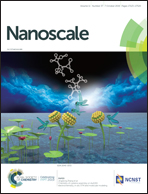A highly selective “turn-on” electroanalysis strategy with reduced copper metal–organic frameworks for sensing histamine and histidine†
Abstract
A highly selective and sensitive electroanalysis strategy has been developed for sensing histamine (HTA) and histidine (His) with “turn-on” signal outputs using copper nanocomposites (Cu NCs) of reduced copper metal–organic frameworks (Cu MOFs). It was discovered that the Cu NC-modified electrodes could display the sharp and stable oxidation peaks of solid-state CuCl electrochemistry at a low potential (about −0.10 V). More interestingly, once HTA or His was introduced, the peaking currents of the electrodes would increase due to the specific interaction between Cu2+ and imidazole groups of HTA or His. A highly selective electroanalysis method was thereby developed for the detection of both HTA and His in the concentration range of 0.010–100 μM. Besides, the application feasibility of the developed electroanalysis strategy was demonstrated for the evaluation of HTA and His separately in red wine and urine samples. Such an electroanalysis candidate for HTA and His holds great potential for wide applications in the fields of food analysis and clinical disease diagnosis.



 Please wait while we load your content...
Please wait while we load your content...